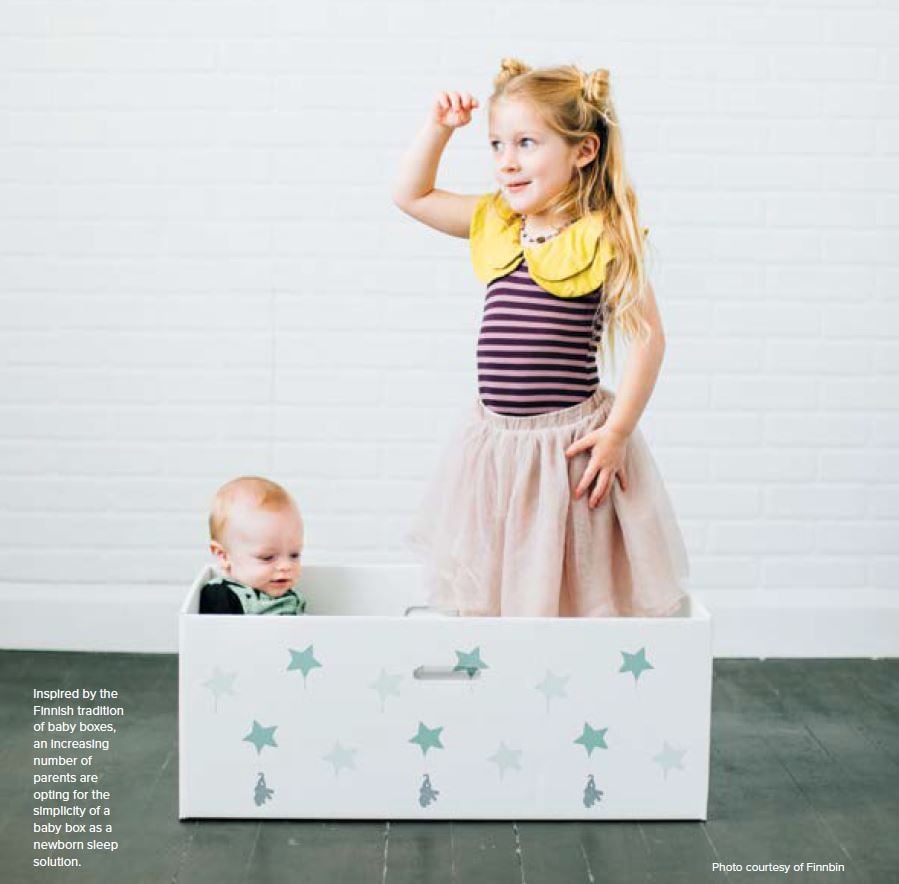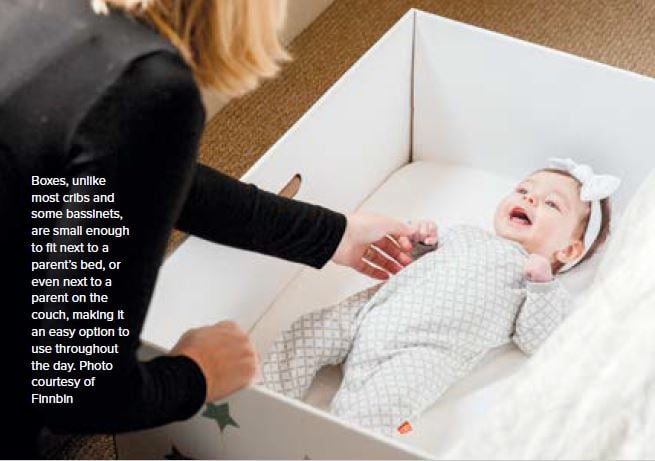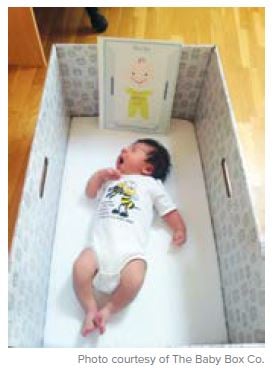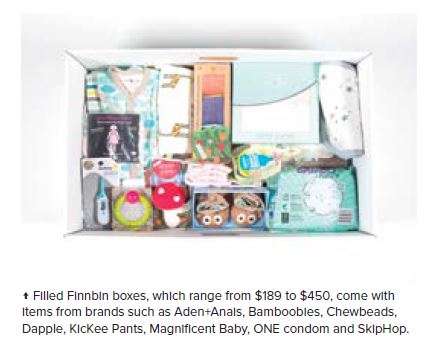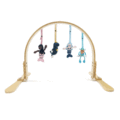a Finnish tradition takes off in Minnesota, giving parents a simple answer to the question: where should our newborn sleep?
Amanda Lindquist can see that her 2-month-old son, Jacob, is getting tired — yawning, fluttering his eyelids, rubbing his eyes.
After he falls asleep her arms, she doesn’t move him to a crib.
Rather, she reaches for a box tucked beside the couch. She lays him down inside its four cozy cardboard walls where he rests soundly for almost two hours.
The concept of putting a baby in a box may sound odd to most people, but this isn’t just any box — this is a baby box designed specifically for safe newborn sleep.
Lindquist, who lives in Duluth, adores hers and uses it frequently.
“When I started using the box, I figured out quickly that it’s a great place for baby to sleep because it’s easy to relocate the box to wherever I am,” she said. “On top of that, our son liked the smaller space from day one.”
A solid start
Baby boxes may be a little-known concept in the U.S., but in Finland they’re just a part of the culture.
For more than 80 years, expectant mothers in the Scandinavian country have received a baby box full of newborn necessities from the government.
Each box, which includes a starter kit of essential supplies such as clothes, bibs and diapers, is lined with a mattress and provides a safe sleep space.
According to a 2013 BBC article, “Why Finnish babies sleep in cardboard boxes,” Finland was a poor country in the 1930s, and infant mortality was high; 65 out of 1,000 babies died.
But the figures improved rapidly in the decades that followed the introduction of baby boxes, plus improved prenatal care for all women in the 1940s, (and a national health insurance system and the central hospital network in the 1960s).
Today Finland boasts one of the lowest infant mortality rates in the world — 2 deaths per 1,000 live births, according to United Nations data, compared to 6 per 1,000 in the U.S.
Every Finnish mother today gets the choice between receiving a baby box or taking a cash grant. Roughly 95 percent opt for the box because it’s worth much more.
Since the original BBC article was published four years ago, the story has been viewed 13 million times and — according to a follow-up story by the BBC — has sparked global interest in the idea, including new companies selling the boxes.
Finnbin sells baby boxes ranging in price from $65 (including a sleeping pad, pad cover and fitted sheet) to $450 (fully stocked with items from trendy brands such as Aden+Anais, Skiphop, Chewbeads, FridaBaby and others).
The Baby Box Co., based in Los Angeles, offers filled boxes from $69.99 to $225 and emphasizes free prenatal and infant-care education for parents with its Baby Box University portal online.
Moved in Minnesota
Inspired by the BBC article about Finland, women and men in many other countries have taken up the cause with new box projects to address infant mortality rates, such as the Barakat Bundle in India (which includes a mosquito net) and the Thula Baba Box in South Africa (a plastic box that can be used as a bath as well as a sleep space).
In Scotland, all babies born after Aug. 15 of this year will receive a baby box, too, featuring a forest fairytale design including Highland cows, squirrels and the Loch Ness Monster, according to the BBC.
In Minnesota, Danielle Selassie of Fridley decided in 2015 to start Babies Need Boxes, a 501(c)3 nonprofit organization headquartered in Minneapolis with a goal of providing a safe and supported start in life for every child.
For Selassie, the box and its contents are more than just useful. She noted the last line of the BBC article that spoke to her so deeply: “The boxes are a symbol of equality and the importance of children.”
“I wanted to show members of our community that we cared about their success as parents and to provide something that was meaningful,” Selassie said. “I thought that the baby boxes were a really practical way to provide tangible support and safe-sleep education to parents.”
In the beginning, Babies Need Boxes took small steps toward big change — by providing baby boxes and newborn-care supplies to seven mothers at a Minneapolis high school.
“It was a really powerful experience and showed me that there are some families in our community who start out with nothing — no diapers, no baby clothes and no safe sleep space for their baby,” Selassie said.
In November, Babies Need Boxes expanded its efforts, thanks to a partnership with The Baby Box Co., which makes the boxes Selassie uses in her packages.
“We now offer baby boxes to any family in the Twin Cities Metro area, regardless of demographic or socioeconomic status,” Selassie said.
Mothers-to-be who are interested in boxes are asked to complete an online class via the Baby Box University, featuring information about box safety, sleep guidelines, vaccines, breastfeeding, car seat use, shaken baby syndrome, and prenatal and infant health, all presented on video by physicians and other experts. (Anyone can access the educational content.)
Mothers who complete the class, which takes about 20 minutes, then receive a certificate to present at a pick-up location in the Twin Cities. They also receive access to more than 7,000 videos on a wide range of topics through Baby Box University.
Selassie said: “By engaging families in conversations and education related to safe sleep practices, newborn care, and other information, we hope to arm people with not only the tangible support needed to be successful but with valuable information needed to feel confident as they start out or continue as parents.”
if we can get parents practicing safe sleep from the time the baby is first at home, we know that, longterm, parents will use these practices more consistently. — Danielle Selassie founder of Babies Need Boxes of Minneapolis
A co-rooming solution
Another factor that may significantly boost the boxes’ popularity is the American Academy of Pediatrics’ 2016 recommendation that parents and babies share the same room — but not the same bed — for the first six months (optimally the first year) to reduce the risk of Sudden Infant Death Syndrome (SIDS).
Boxes, unlike most cribs and some bassinets, are small enough to fit next to a parent’s bed, or even next to a parent on the couch, making it an easy option to use throughout the day.
“Initially I thought I would only use the baby box for naps,” Lindquist said. “I had hoped he would sleep in his crib at night, but I quickly discovered that the baby box was super convenient.”
She could set it up in the living room while she played with her older son, who is 3.
“We put it on the dining room floor while we ate, so Baby could be nearby,” Lindquist said. “At night, Baby is right next to me in his box. It’s been great.”
Baby boxes, which are relatively low cost when compared to bassinets, can also help parents adhere to the AAP’s other sleep guidelines:
Place baby on his or her back on a firm sleep surface such as a crib or bassinet with a tight-fitting sheet.
Avoid the use of soft bedding, including crib bumpers, blankets, pillows, and soft toys.
Are baby boxes safe?
While there are currently no mandatory safety standards for the baby boxes, The Baby Box Co. voluntarily complies with bassinet safety standards as determined by the Consumer Product Safety Commission (CPSC) and American Society for Testing and Materials (ASTM).
Of course, just like a bassinet, a baby box isn’t meant to be a long-term sleep solution.
As a general rule, when an infant can roll over or stand up it’s time for a new safe sleep space, typically at about 5 or 6 months of age.
“They are intended to start parents off with good safe sleep habits from the beginning,” Selassie said. “If we can get parents practicing safe sleep from the time the baby is first at home, we know that long-term, parents will use these practices more consistently.”
The Baby Box Co. assures parents on its website that the boxes are free of “PBDE flame retardants, ozone depleters (CFCs), formaldehyde, prohibited phthalates, mercury, lead or heavy metals.”
The Baby Box Co. plans to introduce a stand sometime in late 2017 to accompany the baby boxes as an accessory.
The AAP’s website doesn’t recommend boxes, nor does it warn against them: “Currently, there is insufficient data on the role cardboard boxes play in reducing infant mortality. Finland does experience a low infant mortality rate, but they have never collected data on the possible role of cardboard boxes. There are many factors that may contribute to the country’s low infant mortality rate — women receive excellent prenatal care; there is very little smoking in the country, and almost all babies sleep on their backs.”
Going nationwide
The grassroots efforts of Babies Need Boxes have already expanded beyond the Twin Cities.
Inspired by a KARE 11 news story about the organization, Lindquist reached out to Selassie to see how she could help.
Today she’s the director of “Northland Operations,” including Duluth. There are also Babies Need Boxes chapters in Ohio, Iowa and North Carolina. Babies Need Boxes is also registered in Canada and the United Kingdom.
Other individuals and organizations, meanwhile, are starting their own programs across the U.S., including the University Health System in San Antonio, which expects to provide 400,000 free baby boxes to new mothers in the coming year in partnership with The Baby Box Co.
Programs are also in the works in select parts of Massachusetts, California, New York and Missouri.
And perhaps most striking of all, government agencies are taking notice: According to a story from CNN, The Baby Box Co. this year is partnering with New Jersey’s Child Fatality and Near Fatality Review Board — using a grant from the Centers of Disease Control and Prevention — to give out 105,000 baby boxes in 2017 to help every baby born in the state.
Selassie dreams of a much broader program in Minnesota, too.
“My hope for the next year is that we are able to develop a network across the state of Minnesota to get safe sleep education and baby boxes into the hands of every parent,” Selassie said. “Five years from now, my hope is that every family has access to a baby box.”
Learn more here:
Laura Malm is a writer, editor and storyteller who lives in Woodbury with her husband and two daughters.



